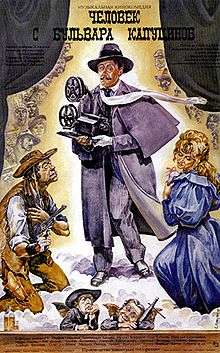A Man from the Boulevard des Capucines
| A Man from the Boulevard des Capucines | |
|---|---|
 Original film poster | |
| Directed by | Alla Surikova |
| Written by | Eduard Akopov |
| Starring |
Andrei Mironov Aleksandra Yakovleva Nikolai Karachentsov Oleg Tabakov Mikhail Boyarsky Igor Kvasha |
| Music by | Gennadi Gladkov |
| Cinematography | Grigori Belenky |
| Edited by | Inessa Brozhovskaya |
Production company | |
| Distributed by | Sovexportfilm |
Release date |
|
Running time | 99 min. |
| Country | Soviet Union |
| Language | Russian |
A Man from the Boulevard des Capucines (Russian: Человек с бульвара Капуцинов, translit. Chelovek s bulvara Kaputsinov) is a Red Western comedy film of 1987 (Mosfilm production), with nods to silent film and the transforming power of celluloid.
It is particularly unusual in Soviet cinema for two reasons: first, it was directed by one of the few female Soviet directors of any stature, Alla Surikova, and second it was a rare post-modernist outing.
The film was the leader of Soviet distribution in 1987 and had 60 million viewers.
Plot
Mr. John First (Johnny) is a cinematographer traveling to Santa Carolina when he is stopped by a band of robbers, headed by Black Jack. Johnny is the only one who does not pull out a gun and fight during the midst of the action and is thus questioned by Black Jack as to why. He then takes the book which Johnny is so fervently looking through and ends up mistaking it for a Bible, until he notices that it contains several blank pages. Johnny explains that it is a book of World Cinema History. Black Jack quickly loses interest and rides away.
When Johnny arrives in Santa Carolina, he comes to the local bar, where a rowdy brawl is in progress. This is a quotidian occurrence, as it is how Harry, the owner of the bar, makes a living by making a few hundred a day from damage. Johnny befriends a cowboy named Billy upon entering, and, while watching the dancers, completely falls in love with one named Diana. Billy laughs at him and warns him that "the heart of Miss [Diana] Little is locked tighter than Fort Knox[1]". When Johnny stands up and asks the crowd if anyone has a white sheet, it is but Diana who is in possession of one. What happens next shocks everyone including Diana. Johnny, in all his gentlemanly ways, comes up to Diana, and respectfully kisses her hand. To a girl used to nothing like that, Diana is so pleasantly appalled that she adds that she has two white sheets, and both of them belong to Johnny.
It all goes downhill from there. When Johnny shows his movies, with the gentlemen who take ladies for walks and tip their hats and say "please" and "thank you", the unruly cowboys begin to change their ways. The only two who do not benefit from this are Harry, who has lost significant profit, and the local pastor, who wants Diana to love him. The latter is in a much worse position, for since Johnny had begun doting on Diana, being the first man in her life to bring her flowers or treat her like a lady in any way, she had completely fallen in love with him and said that her heart will always belong to him.
Although Harry does everything he can, from burning the shed where the films are, to asking Black Jack to murder Johnny, to stealing the white sheet on which the movies were shown, it all seems to slide of the cinematographer's back, until he leaves to find a wedding gift for his beloved Diana. When he returns, he finds all the cowboys reverted to their old ways, due to the coming of Mr. Second, who is also a cinematographer, who shows the cowboys movies with violence and black comedy.
Johnny, with a heavy heart, leaves for the prairie, as he is under the impression that even Diana has left him for the pastor. However, on the way there, he is met by Black Jack, who had seen Johnny's movies through the window and has changed his ways, and Diana, who had captured the pastor and put him at gunpoint and managed to escape. Johnny then leaves with them, determined to help more people see the beauty and new worlds which movies allow us to be in
The film is a comedy critique of the wild west myth. Just as Buffalo Bill mythologized his exploits and later Hollywood elaborated the image, a Soviet film (i.e. the other side of the Cold War) deconstructs and satirizes it, both through the film and the film within film that Johnny First shows. It is a self-reflexive fable documenting its own evolution.
Cast
- Andrei Mironov as Johnny First
- Aleksandra Yakovleva as Ms. Diana Little (singing parts by Larisa Dolina)
- Nikolai Karachentsov as Billy King
- Oleg Tabakov as Harry McKew
- Mikhail Boyarsky as Black Jack
- Igor Kvasha as pastor Adams
- Lev Durov as coffin maker
- Semyon Farada as Mr. Thompson
- Galina Polskikh as Mrs. Thompson
- Natalya Krachkovskaya as Conchita
- Spartak Mishulin as сhief of the Comanches
- Natalya Fateyeva as сhief's wife
- Albert Filozov as Mr. Second
- Mikhail Svetin as pharmacist
- Leonid Yarmolnik as one-eyed cowboy Martin
- Borislav Brondukov as stray cowboy
- Yuriy Dumchev as White Feather
References
- ↑ Fort Knox was built in 1918, much later than the events of this film.